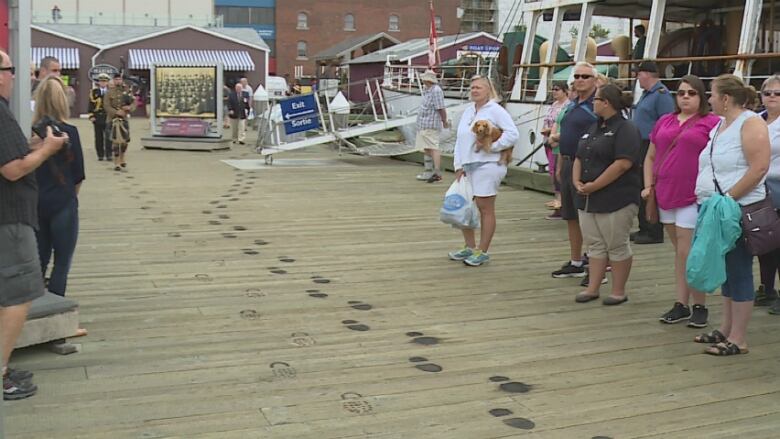Halifax waterfront memorial arch honours First World War soldiers
The Last Steps memorial pays tribute to the departure of the first full battalion of Nova Scotia soldiers

Dozens of boot prints are burned into a boardwalk, vivid black scars that form part of a new memorial honouring tens of thousands of soldiers who left from the port of Halifax to fight in the First World War.
The trail of prints traces the path of the long-gone fighters to a wooden arch on the waterfront bearing the words "The Last Steps," immortalizing the place where many of those soldiers last stood on Canadian soil.
"Halifax is where our nation went to war," Ken Hynes, curator of the Army Museum Halifax Citadel, said Friday at an unveiling ceremony.
"They were real people, just like you and me, who did extraordinary things at an important and formative juncture in the history of Canada."
25th Battalion
The memorial, the first major project of the Army Museum Halifax Citadel and designed by artist Nancy Keating, pays tribute to the departure of the first full battalion of Nova Scotia soldiers to fight in the Great War.
On May 20, 1915, more than 1,000 soldiers with the 25th Battalion (Nova Scotia Rifles) boarded HMTS Saxonia, a converted Cunard ocean liner, bound for the front lines. They were joined by another 1,000 soldiers from what would become Quebec's Royal 22e Regiment, better known as the Van Doos.

Together, the two units would fight side by side for the duration of the war, forging deep bonds during battles in Belgium at Ypres and later in France at the Battle of the Somme, Vimy Ridge, Hill 70 and Passchendaele.
Hynes said the residents of Belgium and France are surrounded by stark reminders of the cost of war.
'Far removed from the battlefields'
"But in this country, so far removed from the battlefields of Europe, there are few public places where citizens can make physical or emotions connections with those who gave the last full measure of themselves for their comrades and for their country," said Hynes.
Dozens gathered under grey skies for Friday's ceremony, where roughly 10 men dressed in First World War uniforms clutched rifles as the crowd sang O Canada.
Musician Brian Doherty strummed a rendition of "Green Fields of France" before a speech from Lt.-Gov. J.J. Grant.
350,000 allied forces
Keating, whose great uncle Maj. Arthur William Porter Weston was onboard the Saxonia, said the boot prints and arch are meant to evoke emotion.
"We've got to have a way to recognize that these people were never the same. My great uncle did survive, but he was never the same. His life did not flourish afterwards, and there were so many that did not come home. So we need to remember that," said Keating just after the ceremony.
During the war, Halifax harbour served as the North American base for the deployment of more than 350,000 allied forces.
Roughly 30,000 Nova Scotians volunteered for military and naval service and 3,400 did not come home.












_(720p).jpg)


 OFFICIAL HD MUSIC VIDEO.jpg)
.jpg)



























































































